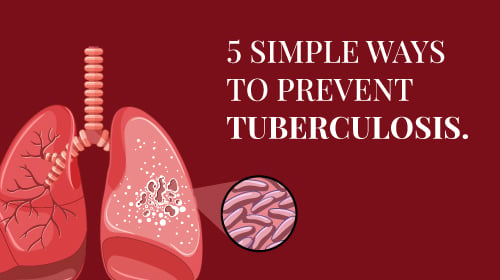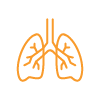Tuberculosis (TB): Symptoms, Types, Diagnosis, and More
April 22, 2022

Overview
Tuberculosis (TB) is a contagious infectious disease that usually attacks your lungs. However, it can also spread to other parts of your body, like your brain and spine. A type of bacteria called Mycobacterium tuberculosis causes it.
In the 20th century, TB was a leading cause of death. Today, Most illnesses can be treated with antibiotics. However, it takes a while. Medications for tuberculosis must be taken for at least 6 to 9 months.
According to the World Health Organization (WHO), 1.5 million people died from the disease in 2020. Tuberculosis is also the thirteenth leading cause of death worldwide. Currently, it is the second leading cause of infectious death after COVID-19.
Contents
Symptoms of Tuberculosis
Typical symptoms of tuberculosis include:
- A persistent cough that lasts more than three weeks and usually causes phlegm, which may be bloody
- Weight loss
- Night sweats
- High fever
- Tiredness
- Loss of appetite
- Neck swelling
You should see a doctor if you have a cough that lasts longer than three weeks or if you are coughing up blood.
Types of Tuberculosis
There are two forms of the disease:
Latent TB: You have germs in your body, but your immune system prevents them from spreading. As a result, you have no symptoms and are not contagious. But the infection is still alive and could one day become active. If you’re at high risk for re-activation, For example, if you have HIV, you had an infection in the past two years, your chest X-ray is unusual, or your immune system is weakened — your doctor will give you medications to prevent active TB.
Active TB: The germs multiply and make you sick. You can transmit the disease to others. 90% of active cases in adults come from latent tuberculosis infection.
Risk Factors of Tuberculosis
Risk factors that increase your chance of contracting the bacteria that cause TB disease include:
- Suffering from diabetes, end-stage renal failure or certain cancers
- Malnutrition
- Tobacco or alcohol for long periods
- A diagnosis of HIV or other weakened immune system condition
- Medications that suppress the immune system can also put people at risk of developing active TB disease.
Other factors include:
- Cancer
- Rheumatoid arthritis
- Crohn’s disease
- Psoriasis
- Lupus
Diagnosis of TB
Healthcare experts can diagnose TB with a few different tests, including a skin check, a blood test, etc. A false-negative result can happen if your immune system isn’t running well or if it’s been less than eight weeks since exposure to TB.
Skin test:
Your physician can use a purified protein derivative (PPD) skin check to diagnose if you’ve TB bacteria. For this test, the doctor will inject 0.1 millilitres (mL) of PPD (a small quantity of protein) under the top layer of your skin. After, 2 and 3 days, you’ll return to your doctor’s office to have the results. A welt in your skin over 5 millimetres (mm) in size where the PPD was injected can be considered a positive result. Reactions between 5 and 15 mm in length may be positive depending on risk factors, health, and medical history.
All responses over 15 mm are considered active, irrespective of risk factors. The test isn’t perfect, though. It can inform you whether or not you’ve got a TB infection. People who’ve recently taken the TB vaccine may also test positive.
Blood check
Your health practitioner can use a blood test to follow up on TB skin outcomes. They might also suggest a blood test first, particularly when you have an existing health condition that can affect your response to the skin check.
Chest X-ray
If you get a positive result from the skin or blood test, your physician will probably recommend a chest X-ray to look for certain small lung spots. These spots, a sign of a TB infection, indicate that your body is attempting to isolate the TB bacteria. A negative chest X-ray can suggest latent TB; however, it’s also feasible your check results were incorrect. Therefore, your physician may also recommend further testing. If the test indicates you’ve got active TB disease, you’ll have to begin treatment for active TB. Otherwise, your health practitioner may also suggest getting treated for latent TB. This can prevent the bacteria from reactivating and making you unwell in the future.
Prevention of Tuberculosis
- Manage the environment : As TB is an airborne infection, the TB bacteria are released into the air when a person with TB coughs or sneezes. Therefore, the threat of disease may be decreased by using a few correct yet easy precautions:
- Proper ventilation : TB can remain suspended in the air for numerous hours without ventilation.
- Natural light : UV light kills off TB microorganisms
- Good hygiene : Masking the mouth and nostrils when coughing or sneezing reduces the spread of TB bacteria. In healthcare settings, the spread of TB is decreased via shielding masks, airflow systems, retaining doubtlessly infectious sufferers cutting different loose sufferers, and the regular screening of healthcare employees for TB.
- A healthy immune system : A healthy immune system is the best defence against TB: 60% of adults with a healthy immune system can kill TB microorganisms.
People also ask
1. What is the First Stage of Tuberculosis?
- Coughing for at least three weeks
- Blood or mucus being coughed up
- Pain in the chest
- Pain during inhaling or coughing
2. What are the Three Stages of TB?
The three stages of TB are:
- Exposure. This happens when a person has been in contact with or exposed to another person with TB.
- Latent TB infection. A person with TB bacteria in their body, but no disease symptoms. The person’s immune system walls off TB organisms, and the TB remains inactive throughout life.
- TB disease. This describes the person who has signs and symptoms of an active infection. In addition, the person would have a positive skin test and a positive chest X-ray.
3. Can TB Cure Itself?
Pulmonary tuberculosis frequently goes away by itself, but the disease can return in more than half of the cases.
4. How Long Does TB Last?
After taking TB medicine for several weeks, doctors can tell TB patients when they can no longer spread TB germs to others. However, most people with TB will need to take TB medicine for at least six months to be cured.








